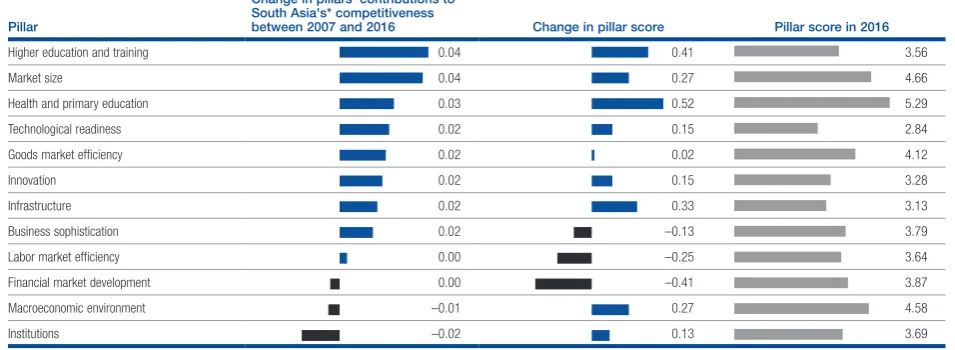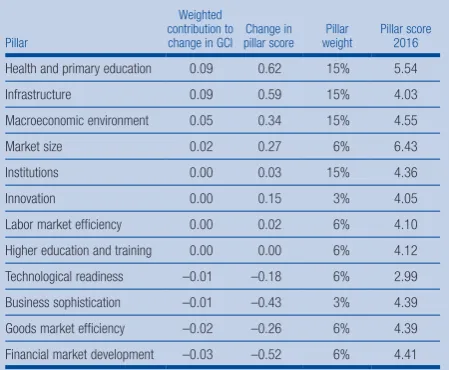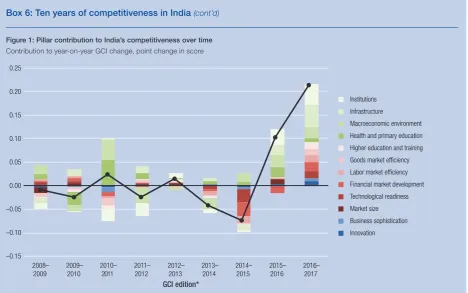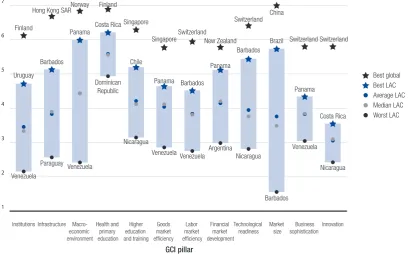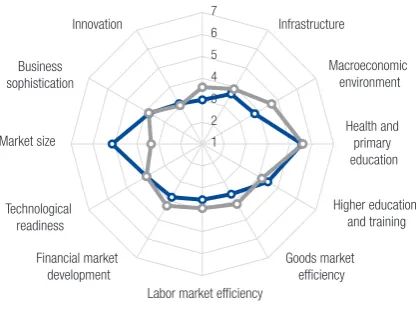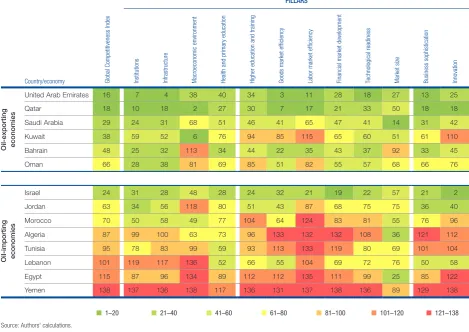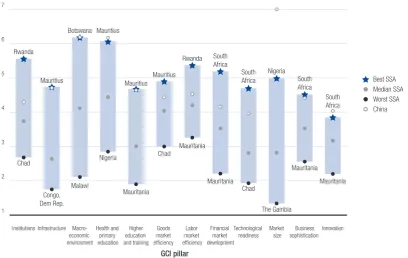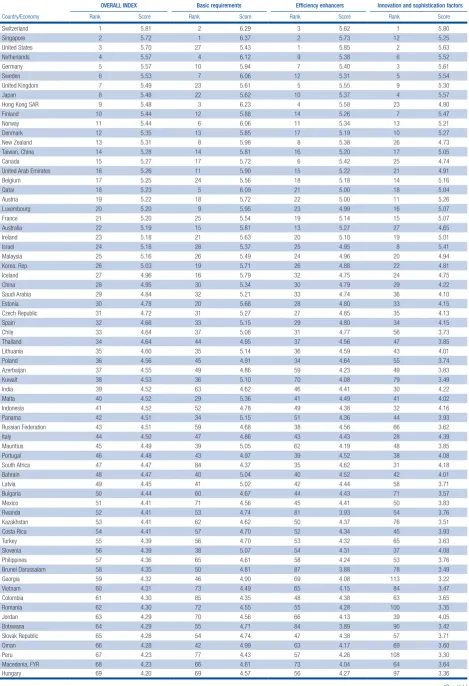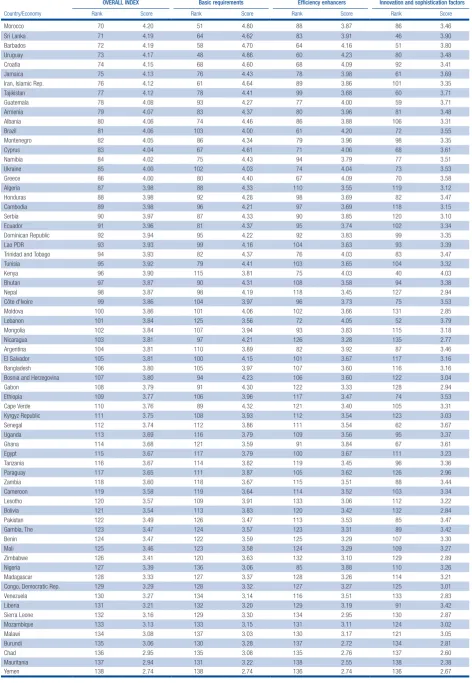Insight Report
Klaus Schwab,
World Economic Forum
The Global
Competitiveness Report
Insight Report
The Global
Competitiveness Report
2016–2017
Professor Klaus Schwab
World Economic Forum
Editor
Professor Xavier Sala-i-Martín
Columbia University
The Global Competitiveness Report 2016–2017 is published by the World Economic Forum within the framework of the Global Competitiveness and Risks Team.
Professor Klaus Schwab
Executive Chairman
Professor Xavier Sala-i-Martín
Chief Advisor of The Global Competitiveness Report Richard Samans
Head of the Centre for the Global Agenda and Member of the Managing Board
Jennifer Blanke
Chief Economist
THE GLOBAL COMPETITIVENESS AND RISKS TEAM
Margareta Drzeniek Hanouz, Head of Global Competitiveness and Risks
Silja Baller, Practice Lead, Competitiveness and Innovation
Ciara Browne, Head of Partnerships
Roberto Crotti, Practice Lead, Competitiveness Research
Attilio Di Battista, Quantitative Economist
Caroline Galvan, Practice Lead, Competitiveness and Risks
Thierry Geiger, Head of Analytics and Quantitative Research
Daniel Gómez Gaviria, Head of Competitiveness Research
Gaëlle Marti, Economist
Stéphanie Verin, Community Specialist
We thank Hope Steele for her superb editing work and Neil Weinberg for his excellent graphic design and layout. We are grateful to Miso Lee, Witold Mucha, and Hassen Naas for their invaluable research assistance.
TERMS OF USE AND DISCLAIMER
The Global Competitiveness Report 2016–2017 (herein: “Report”) presents information and data that were compiled and/or collected by the World Economic Forum (all information and data referred herein as “Data”). Data in this Report is subject to change without notice.
The terms country and nation as used in this Report do not in all cases refer to a territorial entity that is a state as understood by international law and practice. The terms cover well-defined, geographically self-contained economic areas that may not be states but for which statistical data are maintained on a separate and independent basis.
Although the World Economic Forum takes every reasonable step to ensure that the Data thus compiled and/or collected is accurately reflected in this Report, the World Economic Forum, its agents, officers, and employees: (i) provide the Data “as is, as available” and without warranty of any kind, either express or implied, including, without limitation, warranties of merchantability, fitness for a particular purpose and non-infringement; (ii) make no representations, express or implied, as to the accuracy of the Data contained in this Report or its suitability for any particular purpose; (iii) accept no liability for any use of the said Data or reliance placed on it, in particular, for any interpretation, decisions, or actions based on the Data in this Report. Other parties may have ownership interests in some of the Data contained in this Report. The World Economic Forum in no way represents or warrants that it owns or controls all rights in all Data, and the World Economic Forum will not be liable to users for any claims brought against users by third parties in connection with their use of any Data.
The World Economic Forum, its agents, officers, and employees do not endorse or in any respect warrant any third-party products or services by virtue of any Data, material, or content referred to or included in this Report.
Users shall not infringe upon the integrity of the Data and in particular shall refrain from any act of alteration of the Data that intentionally affects its nature or accuracy. If the Data is materially transformed by the user, this must be stated explicitly along with the required source citation.
For Data compiled by parties other than the World Economic Forum, as specified in the “Technical Notes and Sources” section of this Report, users must refer to these parties’ terms of use, in particular concerning the attribution, distribution, and reproduction of the Data. When Data for which the World Economic Forum is the source (herein “World Economic Forum”), as specified in the “Technical Notes and Sources” section of this Report, is distributed or reproduced, it must appear accurately and be attributed to the World Economic Forum. This source attribution requirement is attached to any use of Data, whether obtained directly from the World Economic Forum or from a user.
Users who make World Economic Forum Data available to other users through any type of distribution or download environment agree to make reasonable efforts to communicate and promote compliance by their end users with these terms.
Users who intend to sell World Economic Forum Data as part of a database or as a standalone product must first obtain the permission from the World Economic Forum ([email protected]).
World Economic Forum Geneva
Copyright © 2016
by the World Economic Forum ISBN-13: 978-1-944835-04-0
This book is printed on paper suitable for recycling and made from fully managed and sustained forest sources. Printed and bound in Switzerland.
The Global Competitiveness Report 2016–2017 | iii
Partner Institutes
v
Preface xi
by Richard Samans
The Global Competitiveness Index 2016–2017 Rankings
xiii
Part 1: Measuring Competitiveness
1
1.1 Competitiveness Agendas to Reignite Growth:
Findings from the Global Competitiveness Index
3
by Xavier Sala-i-Martín, Silja Baller, Roberto Crotti, Attilio Di Battista,
Margareta Drzeniek Hanouz, Thierry Geiger, Daniel Gómez Gaviria, and Gaëlle Marti
1.2 Modernizing the Measurement of Drivers of Prosperity
51
in Light of the Fourth Industrial Revolution:
The Updated Global Competitiveness Index
by Xavier Sala-i-Martín, Roberto Crotti, Silja Baller, Attilio Di Battista,
Margareta Drzeniek Hanouz, Thierry Geiger, Daniel Gómez Gaviria, and Gaëlle Marti
1.3 The Executive Opinion Survey:
77
The Voice of the Business Community
by Ciara Browne, Attilio Di Batista, Thierry Geiger, and Stéphanie Verin
Part 2: Country/Economy Profiles
89
How to Read the Country/Economy Profiles 91
Index of Countries/Economies 93
Country/Economy Profiles 94
Technical Notes and Sources
371
About the Authors
381
The Global Competitiveness Report 2016–2017 | v
The World Economic Forum’s Global Competitiveness
and Risks Team is pleased to acknowledge and
thank the following organizations as its valued Partner
Institutes, without which the realization of The Global
Competitiveness Report 2016–2017 would not have
been feasible:
Albania
Institute for Contemporary Studies (ISB) Artan Hoxha, President
Elira Jorgoni, Senior Expert Endrit Kapaj, Expert Algeria
Centre de Recherche en Economie Appliquée pour le Développement (CREAD)
Mohamed Yassine Ferfera, Director Khaled Menna, Research Fellow Argentina
IAE—Universidad Austral
Carlos Marcelo Belloni, Research Analyst
Eduardo Fracchia, Director of Academic Department of Economics
Armenia
Economy and Values Research Center Manuk Hergnyan, Chairman
Sevak Hovhannisyan, Board Member and Senior Associate Australia
Australian Industry Group
Colleen Dowling, Economics Research Coordinator Julie Toth, Chief Economist
Innes Willox, Chief Executive Austria
Austrian Institute of Economic Research (WIFO) Christoph Badelt, Director
Gerhard Schwarz, Coordinator, Survey Department Azerbaijan
Azerbaijan Marketing Society Fuad Aliyev, Deputy Chairman Ashraf Hajiyev, Consultant Bahrain
Bahrain Economic Development Board Khalid Al Rumaihi, Chief Executive
Nada Azmi, Manager, Competitiveness Observatory Fatema Al Atbi, Junior Officer, Competitiveness Observatory Bangladesh
Centre for Policy Dialogue (CPD)
Khondaker Golam Moazzem, Additional Research Director Meherun Nesa, Research Associate
Mustafizur Rahman, Executive Director Barbados
The Sir Arthur Lewis Institute of Social and Economic Studies Don. D. Marshall, Director
Belgium
Vlerick Business School Wim Moesen, Professor Carine Peeters, Professor
Leo Sleuwaegen, Professor, Competence Centre Entrepreneurship, Governance and Strategy Benin
Institut de Recherche Empirique en Economie Politique (IREEP)
Richard Houessou, Research Associate Romaric Samson, Research Assistant Léonard Wantchekon, Director Bhutan
Bhutan Chamber of Commerce & Industry (BCCI) Tshering Lhaden, NTM Desk Officer
Phub Tshering, Secretary General Kesang Wangdi, Deputy Secretary General Bosnia and Herzegovina
MIT Center, School of Economics and Business in Sarajevo, University of Sarajevo
Zlatko Lagumdzija, Professor Zeljko Sain, Executive Director Jasmina Selimovic, Assistant Director Botswana
Botswana National Productivity Centre
Letsogile Batsetswe, Research Consultant and Statistician Baeti Molake, Executive Director
Phumzile Thobokwe, Manager, Information and Research Services Department
Brazil
Fundação Dom Cabral, Innovation Center
Carlos Arruda, Professor and Director FDC Innovation and Entrepreneurship Center
Ana Burcharth, Associate Professor Fernanda Bedê, Research Assistant Brunei Darussalam
Energy and Industry Department at the Prime Minister’s Office Awang Adi Shamsul bin Haji Sabli, Permanent Secretary of
Industry
University of Brunei Darussalam (UBD)
Datin Dayang Hajah Anita Binurul Zahrina binti Pehin Orang Kaya Laila Wijaya Dato Seri Setia Haji Awang Abdul Aziz, Vice-Chancelllor
Bulgaria
Center for Economic Development
Adriana Daganova, Expert, International Programmes and Projects
vi | The Global Competitiveness Report 2016–2017 Partner Institutes
Burundi
Faculty of Economics and Management, Research Centre for Economic and Social Development (CURDES), National University of Burundi
Ferdinand Bararuzunza, Director of the Centre Gilbert Niyongabo, Head of Department Léonidas Ndayizeye, Dean of the Faculty Cambodia
Nuppun Institute for Economic Research (NUPPUN) Chakriya Heng, Administrative Assistant
Pisey Khin, Director
Chanthan Tha, Senior Research Assistant Cameroon
Comité de Compétitivité (SELPI)
Lucien Sanzouango, Permanent Secretary Guy Yakana, Expert Junior
Samuel Znoumsi, Expert Senior Canada
The Conference Board of Canada Michael R. Bloom, Vice President Jessica Edge, Senior Research Associate
Natalie Verania, Marketing and Administrative Assistant Cape Verde
Center for Applied Statistics and Econometrics Research – INOVE
Júlio Delgado, Director
Jerónimo Freire, Project Manager José Mendes, Chief Executive Officer Chad
Groupe de Recherches Alternatives et de Monitoring du Projet Pétrole-Tchad-Cameroun (GRAMP-TC)
Antoine Doudjidingao, Researcher Gilbert Maoundonodji, Director
Celine Nénodji Mbaipeur, Programme Officer Chile
School of Government, Universidad Adolfo Ibáñez Ignacio Briones, Dean
Julio Guzman, Assistant Professor Pamela Saavedra, Assistant China
Institute of Economic System and Management Chen Wei, Division Director and Professor Li Xiaolin, Research Fellow
Li Zhenjing, Deputy Director and Professor
The China Center for Economic Statistics Research, Tianjin University of Finance and Economics
Bojuan Zhao, Professor Lu Dong, Professor
Jian Wang, Associate Professor Hongye Xiao, Professor
Huazhang Zheng, Associate Professor Colombia
National Planning Department
Simon Gaviria, Director National Planning Department Adriana Quiñones, Project Manager
Andres Felipe Trejos, Director of Enterprise Development Colombian Private Council on Competitiveness Rosario Córdoba, President
Rafael Puyana, Vice President Congo, Republic Democratic of Congo-Invest Consulting (CIC) Teza Bila, Managing Director Alphonse Mande, Project Coordinator Daddy Nsiku, Project Coordinator
Côte d’Ivoire
Chamber of Commerce and Industry of Côte d’Ivoire Marie-Gabrielle Boka Varlet, General Manager Anzoumane Diabakate, Head of Communication
Jean-Rock Kouadio-Kirine, Head of Territories and sustainable development
Croatia
National Competitiveness Council Jadranka Gable, Advisor Kresimir Jurlin, Research Fellow Cyprus
European University of Cyprus Research Center
Bambos Papageorgiou, Head of Socioeconomic & Academic Research
Bank of Cyprus Public Company Ltd
Maria Georgiadou, Consultant for Innovation & Entrepreneurship
Charis Pouangare, Director of Corporate Banking and SME Czech Republic
CMC Graduate School of Business Tomáš Janča, Executive Director Denmark
Danish Technological Institute
Hanne Shapiro, Innovation Director, Division for Business and Society
Stig Yding Sørensen, Center Director, Center for Business and Policy Analysis
Ecuador
ESPAE Graduate School of Management, Escuela Superior Politécnica del Litoral (ESPOL)
Virginia Lasio, Director Rafael Coello, Project Assistant Sara Wong, Professor Egypt
The Egyptian Center for Economic Studies (ECES)
Abla Abdel Latif, Executive Director and Director of Research Mohsen Adel, Consultant
Maye Ehab, Economist Estonia
Estonian Institute of Economic Research (EKI) Marje Josing, Director
Enterprise Estonia (EAS)
Hanno Tomberg, Chairman of the Board Ethiopia
African Institute of Management, Development and Governance
Tegegne Teka, Senior ExpertAdugna Girma, Operations Manager
Finland
ETLA—The Research Institute of the Finnish Economy Markku Kotilainen, Research Director
Petri Rouvinen, Research Director Vesa Vihriälä, Managing Director France
HEC Paris, HEC Paris Executive Education
Inge Kerkloh-Devif, Executive Director, Global Business Development
Armelle Dufour, Project Director, Global Initiatives Chloé Hayreaud, Project Manager, Global Business
Development Gabon
The Global Competitiveness Report 2016–2017 | vii Partner Institutes
Gambia, The
Gambia Economic and Social Development Research Institute (GESDRI)
Makaireh A. Njie, Director Georgia
Business Initiative for Reforms in Georgia Tamara Janashia, Executive Director
Giga Makharadze, Founding Member of the Board of Directors Mamuka Tsereteli, Founding Member of the Board of Directors Germany
WHU—Otto Beisheim School of Management Ralf Fendel, Professor, Chair of Monetary Economics Michael Frenkel, Professor, Chair of Macroeconomics and
International Economics Ghana
Association of Ghana Industries (AGI) James Asare-Adjei, President John Defor, Senior Policy Officer
Seth Twum-Akwaboah, Chief Executive Officer Greece
SEV Hellenic Federation of Enterprises
Michael Mitsopoulos, Senior Advisor, Macroeconomic Analysis and European Policy
Thanasis Printsipas, Associate Advisor, Macroeconomic Analysis and European Policy
Guatemala FUNDESA
Felipe Bosch G., President of the Board of Directors Juan Carlos Zapata, Chief Executive Officer Hong Kong SAR
Hong Kong General Chamber of Commerce Rocky Tung, Senior Economist
Hungary
KOPINT-TÁRKI Economic Research Ltd. Éva Palócz, Chief Executive Officer Peter Vakhal, Project Manager Iceland
Innovation Center Iceland
Karl Fridriksson, Managing Director of Human Resources and Marketing
Tinna Jóhannsdóttir, Marketing Manager
Snaebjorn Kristjansson, Operational R&D Manager India
Confederation of Indian Industry (CII) Chandrajit Banerjee, Director General
Danish A. Hashim, Director, Economic Research Marut Sen Gupta, Deputy Director General Indonesia
Center for Industry, SME & Business Competition Studies, University of Trisakti
Ida Busnetty, Vice Director Tulus Tambunan, Director Iran, Islamic Republic of
Iran Chamber of Commerce, Industries, Mines and Agriculture, Department of Economic Affairs Hamed Nikraftar, Project Manager
Farnaz Safdari, Research Associate Homa Sharifi, Research Associate
Ireland
Department of Jobs, Enterprise and Innovation, Competitiveness Unit, Strategic Policy Division Conor Hand, Economist, Senior Policy Analyst Irish Business and Employers’ Confederation (IBEC) Fergal Obrien, Project Manager
School of Economics, University College Cork Stephen Brosnan, Research Assistant Eleanor Doyle, Head of School Sean O’Connor, Research Assistant Israel
Manufacturers Association of Israel (MAI)
Dan Catarivas, Foreign Trade & International Relations Director Yehuda Segev, Managing Director
Shraga Brosh, President Italy
SDA Bocconi School of Management
Paola Dubini, Associate Professor, Bocconi University Francesco A. Saviozzi, SDA Professor, Strategic and
Entrepreneurial Management Department Jamaica
Mona School of Business & Management (MSBM), The University of the West Indies
Patricia Douce, Project Administrator
William Lawrence, Director, Professional Services Unit Densil Williams, Executive Director and Professor Japan
Keio University
Yoko Ishikura, Professor, Graduate School of Media Design Heizo Takenaka, Director, Global Security Research Institute Jiro Tamura, Professor of Law, Keio University
In cooperation with Keizai Doyukai (Japan Association of Corporate Executives)
Kiyohiko Ito, Managing Director, Keizai Doyukai Satoko Okawa, Project Manager
Jordan
Ministry of Planning and International Cooperation Imad Fakhouri, Minister
Mukhallad Omari, Director of Policies and Strategies Kazakhstan
National Analytical Centre Aktoty Aitzhanova, Chairperson
Assylan Akimbayev, Researcher and Analyst Saule Gazizova, Head of Lab
Kenya
Institute for Development Studies, University of Nairobi Paul Kamau, Senior Research Fellow
Dorothy McCormick, Research Professor
Winnie Mitullah, Director and Associate Research Professor Korea, Republic of
Korea Development Institute
Joohoon Kim, Executive Director, Economic Information and Education Center
Youngho Jung, Chief, Public Opinion Analysis Unit Seungjoo Lee, Senior Research Associate, Public Opinion
Analysis Unit Kuwait
viii | The Global Competitiveness Report 2016–2017 Partner Institutes
Kyrgyz Republic Economic Policy Institute
Lola Abduhametova, Program Coordinator Marat Tazabekov, Chairman
Lao PDR
Enterprise & Development Consultants Co., Ltd Latvia
Stockholm School of Economics in Riga
Arnis Sauka, Head of the Centre for Sustainable Development Lebanon
Bader Young Entrepreneurs Program Fadi Bizri, Managing Director Sandrine Hachem, Programs Manager InfoPro, Research Department Lesotho
Private Sector Foundation of Lesotho Nthati Mapitsi, Researcher
Thabo Qhesi, Chief Executive Officer Kutloano Sello, President, Researcher Lithuania
Statistics Lithuania
Ona Grigiene, Deputy Head, Knowledge Economy and Special Surveys Statistics Division
Vilija Lapeniene, Director General
Gediminas Samuolis, Head, Knowledge Economy and Special Surveys Statistics Division
Luxembourg
Luxembourg Chamber of Commerce
Carlo Thelen, Chief Economist, Director General Lynn Zoenen, Research Analyst
Ricarda Braun, Research Analyst Macedonia, FYR
National Entrepreneurship and Competitiveness Council of the Republic of Macedonia – NECC of RM
Dejan Janevski, Project Coordinator Viktorija Mitrikjeska, Administrative Officer Madagascar
Centre of Economic Studies, University of Antananarivo Ravelomanana Mamy Raoul, Director
Razato Rarijaona Simon, Executive Secretary Malawi
Malawi Confederation of Chambers of Commerce and Industry
Hope Chavula, Manager, Head, Public Private Dialogue Chancellor L. Kaferapanjira, Chief Executive Officer Malaysia
Malaysia Productivity Corporation (MPC) Zainon Bakar, Director
Mohd Razali Hussain, Director General Abdul Latif Abu Seman, Deputy Director General Mali
Groupe de Recherche en Economie Appliquée et Théorique (GREAT)
Massa Coulibaly, Executive Director Malta
Competitive Malta
Matthew Castillo, Board Secretary Margrith Lütschg-Emmenegger, President Mauritania
Mauritania Bicom-Service Commercial
Oumou El Khairy Youssouf, Administrative Financial Director Ousmane Samb, Technical and Marketing Director Habib Sy, Analyst
Mauritius
Board of Investment, Mauritius
Manaesha Fowdar, Investment Executive, Competitiveness Ken Poonoosamy, Managing Director
Business Mauritius Raj Makoond, Director Mexico
Center for Intellectual Capital and Competitiveness Erika Ruiz Manzur, Executive Director
René Villarreal Arrambide, President and Chief Executive Tania Guiot, Director
Instituto Mexicano para la Competitividad (IMCO) Gabriela Alarcón, Research Director
Juan E. Pardinas, General Director Mariana Tapia, Researcher Ministry of the Economy
María del Rocío Ruiz Chávez, Undersecretary for Competitiveness and Standardization
Francisco Javier Anaya Rojas, Technical Secretary for Competitiveness
Daniel Zaga Szenker, Deputy General Director Moldova
Academy of Economic Studies of Moldova (AESM)
Grigore Belostecinic, Rector Institute of Economic Research and European Studies (IERES)
Corneliu Gutu, Director Mongolia
Open Society Forum (OSF), Mongolia
Oyunbadam Davaakhuu, Manager of Economic Policy Program
Erdenejargal Perenlei, Executive Director Montenegro
Institute for Strategic Studies and Prognoses (ISSP) Maja Drakic Grgur, Project Manager
Jadranka Kaludjerovic, Program Director Veselin Vukotic, President
Morocco
Confédération Générale des Entreprises du Maroc (CGEM) Meriem Bensalah Cheqroun, President
Si Mohamed Elkhatib, Project Head, Commission Climat des Affaires et Partenariat Public Privé
Ahmed Rahhou, President, Commission Climat des Affaires et Partenariat Public Privé
Mozambique
EconPolicy Research Group, Lda. Peter Coughlin, Director Mwikali Kieti, Project Coordinator Namibia
Institute for Public Policy Research (IPPR) Graham Hopwood, Executive Director Leon Kufa, Research Associate Lizaan van Wyk, Research Associate Nepal
Competitiveness and Development Institute (CODE) Ramesh Chandra Chitrakar, Professor, Country Coordinator
and Project Director
Rabindra Mananda Bajracharya, Team Member Menaka Shrestha, Team Member
Netherlands
INSCOPE: Research for Innovation, Erasmus University Rotterdam
Henk W. Volberda, Director and Professor New Zealand
BusinessNZ
The Global Competitiveness Report 2016–2017 | ix Partner Institutes
Nigeria
Nigerian Economic Summit Group (NESG) Olaoye Jaiyeola, Chief Executive Officer Olajiire Onatade-Abati, Research Analyst Wilson Erumebor, Research Analyst Norway
BI Norwegian Business School
Marius Kristian Nordkvelde, Research Coordinator Ole Jakob Ramsøy, Researcher
Torger Reve, Professor Oman
The International Research Foundation
Azzan Qassim Al-Busaidi, Director General of Planning and Studies
Pakistan Mishal Pakistan
Puruesh Chaudhary, Director Content Amir Jahangir, Chief Executive Officer Paraguay
Centro de Análisis y Difusión de Economia Paraguaya (CADEP)
Dionisio Borda, Research Member Fernando Masi, Director
María Belén Servín, Research Member Peru
Centro de Desarrollo Industrial (CDI), Sociedad Nacional de Industrias
Néstor Asto, Associate Consultant Maria Elena Baraybar, Project Assistant Luis Tenorio, Executive Director Philippines
Makati Business Club (MBC)
Peter Angelo V. Perfecto, Executive Director
Anthony Patrick D. Chua, Special Services Unit Director Mary Elizabeth A. Bautista, Programs Officer
Management Association of the Philippines (MAP) Perry L. Pe, President
Arnold P. Salvador, Executive Director Poland
Department of Financial Stability, National Bank of Poland Piotr Boguszewski, Advisor
Jacek Osinski, Director Portugal
PROFORUM, Associação para o Desenvolvimento da Engenharia
Ilídio António de Ayala Serôdio, President of the Board of Directors
Fórum de Administradores de Empresas (FAE) Paulo Bandeira, General Director
Luis Filipe Pereira, President of the Board of Directors Antonio Ramalho, Member of the Board of Directors Qatar
Qatari Businessmen Association (QBA) Sarah Abdallah, Deputy General Manager Issa Abdul Salam Abu Issa, Secretary-General Social and Economic Survey Research Institute (SESRI) Hanan Abdul Rahim, Associate Director
Darwish Al-Emadi, Director
Raymond Carasig, Contracts and Grants Administrator Romania
Association for Women Entrepreneurship Development (ADAF) Cornelia Rotaru, President
Russian Federation
Eurasia Competitiveness Institute (ECI) Katerina Marandi, Programme Manager Alexey Prazdnichnykh, Managing Director Rwanda
Private Sector Federation (PSF) Benjamin Gasamagera, Chairman
Fiona Uwera, Head of Research and Policy Analysis Saudi Arabia
Alfaisal University
Mohammed Kafaji, Assistant Professor National Competitiveness Center (NCC) Saud bin Khalid Al-Faisal, President Khaldon Zuhdi Mahasen, Managing Director Senegal
Centre de Recherches Economiques Appliquées (CREA), University of Dakar
Ahmadou Aly Mbaye, Director Ndiack Fall, Deputy Director Youssou Camara, Administrative Staff Serbia
Foundation for the Advancement of Economics (FREN) Aleksandar Radivojevic, Project Coordinator
Svetozar Tanaskovic, Researcher Jelena Zarkovic Rakic, Director Singapore
Economic Development Board
Thien Kwee Eng, Assistant Managing Director, Planning Cheng Wai San, Director, Research & Statistics Unit Teo Xinyu, Executive, Research & Statistics Unit Slovak Republic
Business Alliance of Slovakia (PAS) Peter Kremsky, Executive Director Slovenia
Institute for Economic Research Peter Stanovnik, Professor
Sonja Uršic, Senior Research Assistant University of Ljubljana, Faculty of Economics Mateja Drnovšek, Professor
Kaja Rangus, Teaching Assistant South Africa
Business Leadership South Africa Friede Dowie, General Manager Thero Setiloane, Chief Executive Officer Business Unity South Africa
Khanyisile Kweyama, Chief Executive Officer Olivier Serrao, Director, Economic Policy Spain
IESE Business School, International Center for Competitiveness
María Luisa Blázquez, Research Associate Antoni Subirà, Professor
Sri Lanka
Institute of Policy Studies of Sri Lanka (IPS) Raveen Ekanayake, Research Officer Kithmina Hewage, Research Assistant Saman Kelegama, Executive Director Sweden
International University of Entrepreneurship and Technology Association (IUET)
x | The Global Competitiveness Report 2016–2017 Partner Institutes
Switzerland
University of St. Gallen, Executive School of Management, Technology and Law (ES-HSG)
Rubén Rodriguez Startz, Head of Project Tobias Trütsch, Communications Manager Taiwan, China
National Development Council Shien-Quey Kao, Deputy Minister
Chung-Chung Shieh, Researcher, Economic Research Department
Minghuei Wu, Director, Economic Research Department Tajikistan
Center of Sociological Research “Zerkalo” Qahramon Baqozoda, Director
Tanzania
Policy Research for Development, REPOA Cornel Jahari, Assistant Researcher Blandina Kilama, Senior Researcher Donald Mmari, Executive Director Thailand
Chulalongkorn Business School, Chulalongkorn University Pasu Decharin, Dean
Siri-on Setamanit, Assistant Dean Trinidad and Tobago
Arthur Lok Jack Graduate School of Business
Miguel Carillo, Executive Director and Professor of Strategy Nirmala Maharaj, Director, Internationalisation and Institutional
Relations
Richard A Ramsawak, Deputy Director, Centre of Strategy and Competitiveness
The University of the West Indies, St. Augustine
Rolph Balgobin, NGC Distinguished Fellow, Department of Management Studies
Tunisia
Institut Arabe des Chefs d’Entreprises Ahmed Bouzguenda, President Majdi Hassen, Executive Counsellor Turkey
TUSIAD Sabanci University Competitiveness Forum Izak Atiyas, Director
Ozan Bakıs, Project Consultant Sezen Ugurlu, Project Specialist
Uganda
Kabano Research and Development Centre Robert Apunyo, Program Manager Delius Asiimwe, Executive Director Anna Namboonze, Research Associate
Ukraine
CASE Ukraine, Center for Social and Economic Research Dmytro Boyarchuk, Executive Director
Vladimir Dubrovskiy, Leading Economist
United Arab Emirates
Federal Competitiveness and Statistics Authority H.E. Abdulla Nasser Lootah, Director General
Department of Economic Development—Abu Dhabi, Competitiveness Office of Abu Dhabi
H.E. khaleefa Salem Al Mansouri, Undersecretary
Department of Economic Development—Dubai, Competitiveness Office
H.E. Khaled Ibrahim Al kassim, Director of Dubai Competitiveness Office
Zayed University
Mouawiya Al Awad, Director of Institute of Social and Economic Research
United Kingdom LSE Enterprise Ltd
Adam Austerfield, Project Director
Elitsa Garnizova, Project Manager and Researcher Robyn Klingler-Vidra, Senior Researcher
Uruguay
Universidad ORT Uruguay Bruno Gili, Professor Isidoro Hodara, Professor
Venezuela
CONAPRI—The Venezuelan Council for Investment Promotion Litsay Guerrero, Economic Affairs and Investor Services
Manager
Eduardo Porcarelli, Executive Director
Vietnam
Ho Chi Minh Institute for Development Studies (HIDS) Tran Anh Tuan, Acting Director
Du Phuoc Tan, Head of Urban Management Studies Department
Trieu Thanh Son, Deputy Head of Research Management and Cooperation Department
Yemen
Yemeni Business Club (YBC)
Fathi Abdulwasa Hayel Saeed, Chairman Mohammed Ismail Hamanah, Executive Director Ghadeer Ahmed Almaqhafi, Project Coordinator
MARcon Marketing Consulting Margret Arning, Managing Director
Zambia
Institute of Economic and Social Research (INESOR), University of Zambia
Patricia Funjika, Research Fellow
Jolly Kamwanga, Senior Research Fellow and Project Coordinator
Mubiana Macwan’gi, Director and Professor
Zimbabwe
Fulham Economics, Harare A. M. Hawkins, Chairman
Bolivia, Costa Rica, Dominican Republic, El Salvador, Honduras, Nicaragua, Panama
INCAE Business School, Latin American Center for Competitiveness and Sustainable Development (CLACDS) Ronald Arce, Researcher
Arturo Condo, Rector Lawrence Pratt, Director
Liberia and Sierra Leone
The Global Competitiveness Report 2016–2017 | xi
The Global Competitiveness Report 2016–2017 is being
launched at a time of rising income inequality, mounting
social and political tensions, and a general feeling of
uncertainty about the future. Growth remains persistently
low: commodity prices have fallen, as has trade; external
imbalances are increasing; and government finances
are stressed. However, it also comes during one of
the most prosperous and peaceful times in recorded
history, with less disease, poverty, and violent conflict
than ever before. Against this backdrop of seeming
contradictions, the Fourth Industrial Revolution brings
both unprecedented opportunity and an accelerated
speed of change.
Creating the conditions necessary to reignite growth
could not be more urgent. The Report this year is the
latest edition of the Forum’s longstanding cross-country
benchmarking analysis of the factors and institutions that
determine long-term growth and prosperity. Incentivizing
innovation is especially important for finding new growth
engines, but laying the foundations for long-term,
sustainable growth requires working on all factors and
institutions identified in the Global Competitiveness
Index. Leveraging the opportunities of the Fourth
Industrial Revolution will require not only businesses
willing and able to innovate, but also sound institutions,
both public and private; basic infrastructure, health, and
education; macroeconomic stability; and well-functioning
labor, financial, and human capital markets.
Although there is broad consensus on the
importance of the factors currently measured in the
Index, we are undertaking a review process that seeks to
understand the impact of the Fourth Industrial Revolution
on measures of productivity and the drivers of growth.
In the second chapter of this Report, we present our
thinking regarding the potential future structure of the
Index, building on consultations with experts on each
pillar under the thought leadership of our main academic
advisor, Professor Xavier Sala-i-Martín. It explores
new ways of assessing innovation, human capital, and
competitiveness at different stages of development, as
well as our latest thinking on how our benchmarking
tools can be used for policy prioritization.
We face a large challenge—how to build a more
prosperous and inclusive world for all. As a flagship effort
of the Forum’s System Initiative on Economic Growth
and Social Inclusion, The Global Competitiveness
Report serves as a tool for public-private collaboration
on long-term competitiveness agendas contributing to
this objective.
As well as the thought leadership of Professor
Sala-i-Martín, The Global Competitiveness Report
2016–2017 has benefited from the dedication and
collaboration of 160 Partner Institutes worldwide.
We would like to convey our appreciation to all the
business executives who respond to our Executive
Opinion Survey, one of the unique components of
the Index. Appreciation also goes to Professor Klaus
Schwab, Executive Chairman, who developed the
original concept back in 1979; Jennifer Blanke, Chief
Economist; Margareta Drzeniek Hanouz, Head of Global
Competitiveness and Risks; and team members Silja
Baller, Attilio Di Battista, Ciara Browne, Roberto Crotti,
Caroline Galvan, Thierry Geiger, Daniel Gómez Gaviria,
Gaëlle Marti, and Stéphanie Verin.
Preface
RICHARD SAMANS
The Global Competitiveness Report 2016–2017 | xiii East Asia and
the Pacific Eurasia Europe Middle East and North Africa Latin America
and the Caribbean North America South Asia
Sub-Saharan Africa
Note: The Global Competitiveness Index captures the determinants of long-term growth. Recent developments (such as Brexit, commodity price changes, and market volatility) are reflected only in-so-far as they have an impact on data measuring these determinants. The Index should be interpreted in this context.
1 Scale ranges from 1 to 7. 2 2015-2016 rank out of 140 economies. 3 Evolution in percentile rank since 2007.
The Global Competitiveness Index 2016–2017 Rankings
1
Economy Score1 Prev.2 Trend3
Switzerland 5.81 1
Singapore 5.72 2
United States 5.70 3
Netherlands 5.57 5
Germany 5.57 4
Sweden 5.53 9
United Kingdom 5.49 10
Japan 5.48 6
Hong Kong SAR 5.48 7
Finland 5.44 8
Norway 5.44 11
Denmark 5.35 12
New Zealand 5.31 16
Taiwan, China 5.28 15
Canada 5.27 13
United Arab Emirates 5.26 17
Belgium 5.25 19
Qatar 5.23 14
Austria 5.22 23
Luxembourg 5.20 20
France 5.20 22
Australia 5.19 21
Ireland 5.18 24
Israel 5.18 27
Malaysia 5.16 18
Korea, Rep. 5.03 26
Iceland 4.96 29
China 4.95 28
Saudi Arabia 4.84 25
Estonia 4.78 30
Czech Republic 4.72 31
Spain 4.68 33
Chile 4.64 35
Thailand 4.64 32
Lithuania 4.60 36
Poland 4.56 41
Azerbaijan 4.55 40
Kuwait 4.53 34
India 4.52 55
Malta 4.52 48
Indonesia 4.52 37
Panama 4.51 50
Russian Federation 4.51 45
Italy 4.50 43
Mauritius 4.49 46
Portugal 4.48 38
50
Economy Score1 Prev.2 Trend3
South Africa 4.47 49
Bahrain 4.47 39
Latvia 4.45 44
Bulgaria 4.44 54
Mexico 4.41 57
Rwanda 4.41 58
Kazakhstan 4.41 42
Costa Rica 4.41 52
Turkey 4.39 51
Slovenia 4.39 59
Philippines 4.36 47
Brunei Darussalam 4.35 n/a
Georgia 4.32 66
Vietnam 4.31 56
Colombia 4.30 61
Romania 4.30 53
Jordan 4.29 64
Botswana 4.29 71
Slovak Republic 4.28 67
Oman 4.28 62
Peru 4.23 69
Macedonia, FYR 4.23 60
Hungary 4.20 63
Morocco 4.20 72
Sri Lanka 4.19 68
Barbados 4.19 n/a
Uruguay 4.17 73
Croatia 4.15 77
Jamaica 4.13 86
Iran, Islamic Rep. 4.12 74
Tajikistan 4.12 80
Guatemala 4.08 78
Armenia 4.07 82
Albania 4.06 93
Brazil 4.06 75
Montenegro 4.05 70
Cyprus 4.04 65
Namibia 4.02 85
Ukraine 4.00 79
Greece 4.00 81
Algeria 3.98 87
Honduras 3.98 88
Cambodia 3.98 90
Serbia 3.97 94
Ecuador 3.96 76
Dominican Republic 3.94 98
84
Economy Score1 Prev.2 Trend3
Lao PDR 3.93 83
Trinidad and Tobago 3.93 89
Tunisia 3.92 92
Kenya 3.90 99
Bhutan 3.87 105
Nepal 3.87 100
Côte d’Ivoire 3.86 91
Moldova 3.86 84
Lebanon 3.84 101
Mongolia 3.84 104
Nicaragua 3.81 108
Argentina 3.81 106
El Salvador 3.81 95
Bangladesh 3.80 107
Bosnia & Herzegovina 3.80 111
Gabon 3.79 103
Ethiopia 3.77 109
Cape Verde 3.76 112
Kyrgyz Republic 3.75 102
Senegal 3.74 110
Uganda 3.69 115
Ghana 3.68 119
Egypt 3.67 116
Tanzania 3.67 120
Paraguay 3.65 118
Zambia 3.60 96
Cameroon 3.58 114
Lesotho 3.57 113
Bolivia 3.54 117
Pakistan 3.49 126
Gambia, The 3.47 123
Benin 3.47 122
Mali 3.46 127
Zimbabwe 3.41 125
Nigeria 3.39 124
Madagascar 3.33 130
Congo, Democratic Rep. 3.29 n/a
Venezuela 3.27 132
Liberia 3.21 129
Sierra Leone 3.16 137
Mozambique 3.13 133
Malawi 3.08 135
Burundi 3.06 136
Chad 2.95 139
Mauritania 2.94 138
Yemen 2.74 n/a
Part 1
The Global Competitiveness Report 2016–2017 | 3
CHAPTER 1.1
Competitiveness
Agendas to Reignite
Growth: Findings
from the Global
Competitiveness Index
XAVIER SALA-I-MARTÍN
Columbia University
SILJA BALLER
ROBERTO CROTTI
ATTILIO DI BATTISTA
MARGARETA DRZENIEK HANOUZ
THIERRY GEIGER
DANIEL GÓMEZ GAVIRIA
GAËLLE MARTI
World Economic Forum
The Global Competitiveness Report 2016–2017 comes
out in the context of persistent slow growth and a
near-term outlook that is fraught with renewed uncertainty
fueled by continued geopolitical turmoil, financial market
fragility, and sustained high debt levels in emerging
markets. Despite unorthodox monetary policy, global
GDP growth has fallen from levels of 4.4 percent in
2010 to 2.5 percent in 2015. This fall in growth reflects
not only the productivity slowdown documented in last
year’s Report, which has continued during 2016, but
also what now seems like a long-term downward trend in
investment rates.
1Future growth prospects are constrained by
longer-term trends. Many economies around the world struggle
with the double challenges of slowing productivity
growth and rising income inequality, often exacerbated
by rapidly aging societies. Stagnating and unequally
distributed income growth in turn has opened the door
to more inward-looking policies, mounting protectionist
pressures, and a general questioning of the premises
underlying globalization in many economies—most visibly
embodied in the recent Brexit vote. At the same time,
in emerging markets, the end of the commodity
super-cycle has led to an abrupt economic slowdown that
has exposed the slow pace or lack of
competitiveness-enhancing reforms in recent years, which could increase
polarization and threaten social cohesion.
On the bright side, tremendous promise for higher
economic growth and societal progress dawns with the
Fourth Industrial Revolution.
2Based on digital platforms,
the Fourth Industrial Revolution is characterized by a
convergence of technologies that is blurring the lines
between the physical, digital, and biological spheres
(Box 1). Breakthroughs in technologies such as artificial
intelligence, biotechnology, robotics, the Internet of
Things, and 3D printing, to name a few, will provide new
avenues for growth and development in the future but
could also give rise to significant social challenges.
The political and ideological constraints placed
on fiscal policy in the wake of the financial crisis left
monetary policy as the only option for governments in
advanced economies to try to avert secular stagnation.
3Although this may have been successful in stabilizing
growth in the short term, ensuring a higher future
growth path will necessitate continued
competitiveness-enhancing supply-side reforms and investment to
strengthen productive sectors. And as the Fourth
Industrial Revolution is gathering speed, it will be
increasingly important to support the emergence of new
sectors of economic activity through competitiveness
reforms that foster innovation. Yet, as the Global
The authors would like to thank Miso Lee for research support for this
1.1: Findings from the Global Competitiveness Index
4 | The Global Competitiveness Report 2016–2017
We are at the beginning of a global transformation that is
characterized by the convergence of digital, physical, and
biological technologies in ways that are changing both
the world around us and our very idea of what it means to
be human. The changes are historic in terms of their size,
speed, and scope.
This transformation—the Fourth Industrial
Revolution—is not defined by any particular set of
emerging technologies themselves, but rather by the
transition to new systems that are being built on the
infrastructure of the digital revolution. As these individual
technologies become ubiquitous, they will fundamentally
alter the way we produce, consume, communicate, move,
generate energy, and interact with one another.
And given the new powers in genetic engineering
and neurotechnologies, they may directly impact who we
are and how we think and behave. The fundamental and
global nature of this revolution also poses new threats
related to the disruptions it may cause—affecting labor
markets and the future of work, income inequality, and
geopolitical security as well as social value systems and
ethical frameworks.
Adapted from Klaus Schwab, The Fourth Industrial Revolution, 2016.
Box 1: The Fourth Industrial Revolution
selected for World Economic Regional Summits in 2017
follow.
The second chapter presents the framework of
the modernized Global Competitiveness Index and
some preliminary results, building on work presented
in The Global Competitiveness Report 2015–2016. It
highlights new indicators, new concepts of innovation,
new approaches to measuring human capital, and a
new approach to policy prioritization. The third chapter
describes the Executive Opinion Survey, an invaluable
and unique source of current data from which we
derive a large number of indicators used in the GCI.
The Country/Economy Profiles section at the end of the
Report presents the detailed GCI results by economy
and is a useful complement to the present chapter.
5METHODOLOGY
We define competitiveness as the set of institutions,
policies, and factors that determine the level of
productivity of an economy, which in turn sets the level
of prosperity that the country can achieve.
Since 2005, building on Klaus Schwab’s original
idea of 1979, the World Economic Forum has published
the Global Competitiveness Index (GCI) developed by
Xavier Sala-i-Martín in collaboration with the Forum.
The GCI combines 114 indicators that capture concepts
that matter for productivity and long-term prosperity
(described in greater detail in Appendix A).
These indicators are grouped into 12 pillars
(Figure 1): institutions, infrastructure, macroeconomic
environment, health and primary education, higher
education and training, goods market efficiency,
labor market efficiency, financial market development,
technological readiness, market size, business
sophistication, and innovation. These pillars are in turn
organized into three subindexes: basic requirements,
efficiency enhancers, and innovation and sophistication
factors. The three subindexes are given different weights
in the calculation of the overall Index, depending on
each economy’s stage of development, as proxied by
its GDP per capita and the share of exports represented
by raw materials. Appendix A presents a description
of each pillar, a classification of economies by stage
of development, the detailed structure of the GCI, and
a description of the various steps of its computation,
including normalization and aggregation.
6The GCI includes statistical data from internationally
recognized organizations, notably the International
Monetary Fund (IMF); the World Bank; and various
United Nations’ specialized agencies, including the
International Telecommunication Union, UNESCO, and
the World Health Organization. The Index also includes
indicators derived from the World Economic Forum’s
Executive Opinion Survey that reflect qualitative aspects
of competitiveness, or for which comprehensive and
Competitiveness Index (GCI) shows, to date, progress in
building an enabling environment for innovation remains
the advantage of only a few economies. Last but not
least, future growth will also depend on the ability of
economies to safeguard the benefits of openness to
trade and investment that has led to record reductions in
poverty rates in recent decades.
4Against this background, this Report serves as a
critical reminder of the importance of competitiveness in
solving both our international macroeconomic challenges
and laying the ground for future prosperity.
Recovering growth in the context of the Fourth
Industrial Revolution will require the recognition
that policymakers need a shared assessment and
understanding of the future sources of competitiveness.
By reducing complexity and providing a tool to identify
strengths and weaknesses and track progress, the
Report serves as a means to inform this conversation
and to support policymakers, businesses, and civil
society in their development of a shared long-term vision
(see Box 2 for two examples of how the Report is being
used).
The Global Competitiveness Report 2016–2017 | 5 1.1: Findings from the Global Competitiveness Index
comparable statistical data are not available for a
sufficiently large number of economies (see Chapter 1.3).
The Report this year covers 138 economies
included based on data availability. Some have been
reinstated in the 2016 edition of the Survey after one
or more years of exclusion. These are Barbados and
Yemen (last included in 2014) and Brunei Darussalam
(last included in 2013). For the first time ever, the Survey
was administered in the Democratic Republic of Congo.
However, it was not completed to minimum requirements
in Guinea, Guyana, Haiti, Myanmar, Seychelles, and
Swaziland. For this reason, these economies are not
included in this year’s edition of the Report. Altogether,
the combined output of the economies covered in the
GCI accounts for 98 percent of world GDP.
7RESULTS OVERVIEW AND MAIN FINDINGS
Table 1 presents the rankings of the GCI 2016–2017
and Appendix B reports the rankings by pillar and
subindex. Many of the competitiveness challenges
we see today stem from the aftermath of the financial
crisis. Today, productivity and growth are not picking
up in advanced economies, and the consequences
of low and even negative productivity growth in many
emerging economies are now evident. The great
recession led many advanced economies to implement
very loose monetary policy, which in turn fueled a global
commodities boom (Box 3) that masked many of the
competitiveness challenges of commodity-exporting
emerging markets. Vulnerability to commodity price
fluctuations in emerging economies and the promises
of the Fourth Industrial Revolution underscore the
importance of innovation as a source of competitiveness
and economic diversification to reignite growth.
Against this background, it is clear that (1) monetary
stimulus is not enough to reignite growth if economies
are not competitive, (2) an increasingly important element
of competitiveness is creating an enabling environment
for innovation, and (3) innovation in turn goes hand in
hand with openness and economic integration.
Monetary policy is not enough: Insufficient
competitiveness is a constraint for reigniting
growth worldwide
In the aftermath of the 2007–2009 financial crisis,
many central banks and governments have resorted to
monetary policy to try to jumpstart growth. However,
near-zero or negative real interest rates have left little
further scope for traditional monetary policy, and
quantitative easing—the process of buying assets and
increasing the size of central bank balance sheets—has
delivered mixed results in spurring growth.
Pillar 5. Higher education
and training
Pillar 6. Goods market efficiency
Pillar 7. Labor market efficiency
Pillar 8. Financial market
development
Pillar 9. Technological readiness
Pillar 10. Market size
Pillar 11. Business sophistication
Pillar 12. Innovation
Pillar 1. Institutions
Pillar 2. Infrastructure
Pillar 3. Macroeconomic
environment
Pillar 4. Health and primary
education
Figure 1: The Global Competitiveness Index framework
Key for
factor-driven
economies
Key for
efficiency-driven
economies
Key for
innovation-driven
economies
Pillar 1. Institutions
Pillar 2. Infrastructure
Pillar 3. Macroeconomic
environment
Pillar 4. Health and primary
education
Pillar 11. Business sophistication
Pillar 12. Innovation
Pillar 5. Higher education and
training
Pillar 6. Goods market efficiency
Pillar 7. Labor market efficiency
Pillar 8. Financial market
development
Pillar 9. Technological readiness
Pillar 10. Market size
Basic requirements
subindex
Efficiency enhancers
subindex
Innovation and sophistication
factors subindex
GLOBAL COMPETITIVENESS INDEX
1.1: Findings from the Global Competitiveness Index
6 | The Global Competitiveness Report 2016–2017
The Global Competitiveness Report,
published since
1979, aims to serve as a neutral and objective tool for
governments, the private sector, and civil society to work
together on effective public-private collaboration to boost
future prosperity. By benchmarking each year’s progress
on different factors and institutions that matter for future
growth, the
Report
keeps competitiveness on the public
agenda, provides a focal point for the discussion of long-term
competitiveness policies, and helps to keep stakeholders
accountable.
The ability to compare 138 economies on a variety
of indicators helps them to assess gaps and priority areas
and to construct joint, public-private agendas to address
them. The annual updating of the Index allows countries to
track their progress and reassess their agendas, adjusting
them if necessary. Some countries have used the Index to
build entire competitiveness systems and formally organize
their institutions for competitiveness, as illustrated by two
examples from Latin America and the Caribbean: the
Dominican Republic and Colombia.
The Dominican Republic
In 2014, a group of leading Dominican business leaders
began discussions about increasing the country’s
competitiveness levels, and mitigating the risks it faces,
through a public-private partnership. In August 2015, the
Initiative for National Productivity and Competitiveness (IPCN
in Spanish) was created by presidential decree and tasked
with identifying and promoting actions and reforms that would
strengthen productivity and competitiveness.
1The IPCN comprises 35 business leaders and five
government ministers: the Minister of the Presidency;
the Minister of Industry and Commerce; the Minister of
Economics, Planning and Development; the Minister of
Finance; and the Administrative Minister of the Presidency.
Members of the IPCN agreed to use globally recognized
indicators, particularly the Global Competitiveness Index
(GCI), to set common goals and coordinate actions between
the public and private sectors through three mechanisms:
• Nine working groups, organized around the GCI’s 12
pillars of competitiveness, are responsible for
formulat-ing action plans and proposals—with priority given to
the groups working on pillars on which the Dominican
Republic is underperforming. After the first working
peri-od, 15 projects were selected, including legal reforms to
facilitate creating businesses, a digital platform for import
and export procedures, structural changes to improve the
transportation system, adjustments to quality control
pro-cesses, and amendments to taxation legislation.
• The Ventanilla de Consultas is an online platform that
serves as a communication channel between the
pub-lic and the IPCN—any citizen may propose actions to
improve national or regional competitiveness and
produc-tivity. So far this has led to the creation of a commission
to aid the private sector in its preparations for an
evalua-tion by the Financial Acevalua-tion Task Force, and to a
presiden-tial decree protecting low-income homeowners from new
tax legislation.
• The Public-Private Partnerships Promotion Unit
identi-fies and evaluates public-private investment projects
that could have a large impact on national development,
benchmarking them against international PPP best
practices. A new PPP law is being written by a team of
experts, including the IPCN’s technical support committee
and other members of the public and private sectors.
Colombia
The National System of Competitiveness (SNC) was
established in 2006 to coordinate the activities of Colombia’s
national government with the private sector, academia,
and civil society on issues related to productivity and
economic development. Regional Commissions for
Competitiveness (RCCs) were also created, to coordinate
policy implementation. Within this system, the Private
Competitiveness Council was launched by a group of large
Colombian firms and universities to be the voice of the private
sector. The Council now constitutes the system’s think tank,
and uses tools such as
The Global Competitiveness Report.
2The system is coordinated by a Presidential Adviser
for Competitiveness and Innovation and led by an Executive
Committee composed of three government officials (the
Minister of Trade and Industry, the Director of National
Planning, and the Director of Colciencias [the National
Administrative Department for Science, Technology and
Innovation]) and two representatives from the private sector
(President of the Private Competitiveness Council and
President of Confecamaras [the Business Association of
Chambers of Commerce]). The Executive Committee also
coordinates work with the RCCs and presents annual reports
to the National Competitiveness Assembly.
In an ongoing effort to improve capacity to make
progress on the competitiveness agenda, the system was
recently merged with the Science, Technology and Innovation
System; a project management model was implemented;
and governance was revamped to better coordinate with the
regions and improve empowerment and accountability by
introducing a requirement for the Executive Committee to
report to the full Council of Ministers.
The system has successfully improved coordination
among government agencies, producing a policy document
on productive development and implementing an 11-point
competitiveness agenda with concrete projects and
accountability.
Notes
1 Text for this section is contributed by Members of the CTA (Comité Tecnico de apoyo de la Iniciativa para la Productividad y Competitividad Nacional-IPCN) and Rafael Esteva, Researcher from Grupo Privado para la Competitividad Nacional from the Dominican Republic.
2 This text draws on the article by Jaime Bueno Miranda “How Can Colombia Become More Competitive?“ available at https://www. weforum.org/agenda/2016/06/how-colombia-has-become-more-competitive/.
The Global Competitiveness Report 2016–2017 | 7 1.1: Findings from the Global Competitiveness Index
GCI 2016–2017 GCI 2015–2016
Country/Economy
Switzerland 1 5.81 1 5.76
Singapore 2 5.72 2 5.68
United States 3 5.70 3 5.61
Netherlands 4 5.57 5 5.50
Germany 5 5.57 4 5.53
Sweden 6 5.53 9 5.43
United Kingdom 7 5.49 10 5.43
Japan 8 5.48 6 5.47
Hong Kong SAR 9 5.48 7 5.46
Finland 10 5.44 8 5.45
Norway 11 5.44 11 5.41
Denmark 12 5.35 12 5.33
New Zealand 13 5.31 16 5.25
Taiwan, China 14 5.28 15 5.28
Canada 15 5.27 13 5.31
United Arab Emirates 16 5.26 17 5.24
Belgium 17 5.25 19 5.20
Qatar 18 5.23 14 5.30
Austria 19 5.22 23 5.12
Luxembourg 20 5.20 20 5.20
France 21 5.20 22 5.13
Australia 22 5.19 21 5.15
Ireland 23 5.18 24 5.11
Israel 24 5.18 27 4.98
Malaysia 25 5.16 18 5.23
Korea, Rep. 26 5.03 26 4.99
Iceland 27 4.96 29 4.83
China 28 4.95 28 4.89
Saudi Arabia 29 4.84 25 5.07
Estonia 30 4.78 30 4.74
Czech Republic 31 4.72 31 4.69
Spain 32 4.68 33 4.59
Chile 33 4.64 35 4.58
Thailand 34 4.64 32 4.64
Lithuania 35 4.60 36 4.55
Poland 36 4.56 41 4.49
Azerbaijan 37 4.55 40 4.50
Kuwait 38 4.53 34 4.59
India 39 4.52 55 4.31
Malta 40 4.52 48 4.39
Indonesia 41 4.52 37 4.52
Panama 42 4.51 50 4.38
Russian Federation 43 4.51 45 4.44
Italy 44 4.50 43 4.46
Mauritius 45 4.49 46 4.43
Portugal 46 4.48 38 4.52
South Africa 47 4.47 49 4.39
Bahrain 48 4.47 39 4.52
Latvia 49 4.45 44 4.45
Bulgaria 50 4.44 54 4.32
Mexico 51 4.41 57 4.29
Rwanda 52 4.41 58 4.29
Kazakhstan 53 4.41 42 4.48
Costa Rica 54 4.41 52 4.33
Turkey 55 4.39 51 4.37
Slovenia 56 4.39 59 4.28
Philippines 57 4.36 47 4.39
Brunei Darussalam 58 4.35 n/a n/a
Georgia 59 4.32 66 4.22
Vietnam 60 4.31 56 4.30
Colombia 61 4.30 61 4.28
Romania 62 4.30 53 4.32
Jordan 63 4.29 64 4.23
Botswana 64 4.29 71 4.19
Slovak Republic 65 4.28 67 4.22
Oman 66 4.28 62 4.25
Peru 67 4.23 69 4.21
Macedonia, FYR 68 4.23 60 4.28
Hungary 69 4.20 63 4.25
Table 1: Global Competitiveness Index 2016–2017 rankings and 2015–2016 comparisons
GCI 2016–2017 GCI 2015–2016
Country/Economy
Morocco 70 4.20 72 4.16
Sri Lanka 71 4.19 68 4.21
Barbados 72 4.19 n/a n/a
Uruguay 73 4.17 73 4.09
Croatia 74 4.15 77 4.07
Jamaica 75 4.13 86 3.97
Iran, Islamic Rep. 76 4.12 74 4.09
Tajikistan 77 4.12 80 4.03
Guatemala 78 4.08 78 4.05
Armenia 79 4.07 82 4.01
Albania 80 4.06 93 3.93
Brazil 81 4.06 75 4.08
Montenegro 82 4.05 70 4.20
Cyprus 83 4.04 65 4.23
Namibia 84 4.02 85 3.99
Ukraine 85 4.00 79 4.03
Greece 86 4.00 81 4.02
Algeria 87 3.98 87 3.97
Honduras 88 3.98 88 3.95
Cambodia 89 3.98 90 3.94
Serbia 90 3.97 94 3.89
Ecuador 91 3.96 76 4.07
Dominican Republic 92 3.94 98 3.86
Lao PDR 93 3.93 83 4.00
Trinidad and Tobago 94 3.93 89 3.94
Tunisia 95 3.92 92 3.93
Kenya 96 3.90 99 3.85
Bhutan 97 3.87 105 3.80
Nepal 98 3.87 100 3.85
Côte d'Ivoire 99 3.86 91 3.93
Moldova 100 3.86 84 4.00
Lebanon 101 3.84 101 3.84
Mongolia 102 3.84 104 3.81
Nicaragua 103 3.81 108 3.75
Argentina 104 3.81 106 3.79
El Salvador 105 3.81 95 3.87
Bangladesh 106 3.80 107 3.76
Bosnia and Herzegovina 107 3.80 111 3.71
Gabon 108 3.79 103 3.83
Ethiopia 109 3.77 109 3.74
Cape Verde 110 3.76 112 3.70
Kyrgyz Republic 111 3.75 102 3.83
Senegal 112 3.74 110 3.73
Uganda 113 3.69 115 3.66
Ghana 114 3.68 119 3.58
Egypt 115 3.67 116 3.66
Tanzania 116 3.67 120 3.57
Paraguay 117 3.65 118 3.60
Zambia 118 3.60 96 3.87
Cameroon 119 3.58 114 3.69
Lesotho 120 3.57 113 3.70
Bolivia 121 3.54 117 3.60
Pakistan 122 3.49 126 3.45
Gambia, The 123 3.47 123 3.48
Benin 124 3.47 122 3.55
Mali 125 3.46 127 3.44
Zimbabwe 126 3.41 125 3.45
Nigeria 127 3.39 124 3.46
Madagascar 128 3.33 130 3.32
Congo, Democratic Rep. 129 3.29 n/a n/a
Venezuela 130 3.27 132 3.30
Liberia 131 3.21 129 3.37
Sierra Leone 132 3.16 137 3.06
Mozambique 133 3.13 133 3.20
Malawi 134 3.08 135 3.15
Burundi 135 3.06 136 3.11
Chad 136 2.95 139 2.96
Mauritania 137 2.94 138 3.03
Yemen 138 2.74 n/a n/a
Source: Authors' calculations.
1.1: Findings from the Global Competitiveness Index
8 | The Global Competitiveness Report 2016–2017
Box 3: Competitiveness at the end of the commodity boom
1 2 3 4 5 6 7
1 2 3 4 5 6 7
Figure 1: Correlation between GCI score and diversification
Average GCI score, 2007–2010
Source: Authors’ calculations based on IMF Diversification Index.
Note: Higher diversification scores indicate more concentrated (less diversified) export baskets based on a sample of 117 economies.
Today’s competitiveness landscape is the outcome of
developments stemming from the global financial crisis
which spread negative wealth shocks and contractionary
effects from the United States to Europe and beyond.
1After
reducing interest rates toward zero and all but exhausting the
possibilities of conventional monetary policy to spur recovery,
policymakers resorted to more unorthodox solutions. Central
banks’ strategy of quantitative easing continues today, as they
inflate their balance sheets and keep interest rates at record
lows. This box explores the link between these well-known
macro policies and diversification and competitiveness.
The end of the commodity super-cycle and the sharp
drop in prices, mainly of oil and minerals but also of food
and agricultural products, reveals a close relationship
between commodity dependence and competitiveness and
provides lessons going forward. As prices of commodities
soared following the global financial crisis, reinforced by
strong demand from a few large emerging markets known
as the BRICs (Brazil, Russia, India, and China), the weight
of commodities in the export baskets of commodity-rich
economies increased. The continued strong growth of
the BRIC economies, particularly China, reinforced the
commodity super-cycle that had begun in 2000 after the
long slump of the 1980s and 1990s.
2Close-to-zero interest
rates in advanced economies induced large capital flows into
emerging markets that went to these profitable commodity
sectors. The dollar depreciation super-cycle was matched
by currency appreciations that some claim produced Dutch
disease phenomena in emerging markets. Commodity
sectors attracted resources and manufacturing sectors found
it harder to export and harder to attract investment.
The end of the commodity super-cycle, and in particular
the pronounced fall in oil prices in response to increased
supply of unconventional oil sources, especially in the United
States, produced a large drop in the value of exports, current
account deficits, government budget deficits, and large
currency depreciations. As the US economy slowly recovered
and monetary policy was expected to normalize, capital
flows toward emerging markets fell. Many policymakers
and analysts hoped that exchange rate depreciations
would lead to increased exports of manufacturing goods.
They soon realized that, for a variety of reasons—including
depressed global trade in general, smaller real versus
nominal depreciations, and the changing structure of global
value chains and international trade—export elasticities had
become smaller than they used to be (exports became less
responsive to changes in the exchange rate).
3The key lesson learned, however, is that the process of
starting to produce new goods in new sectors and managing
to export them is hard. It requires having productivity levels
beyond those achieved by commodity-exporting economies.
Indeed, using the IMF Diversification Index, we find that
more competitive economies also have more diversified
export baskets, and more diversified economies are more
competitive. The link between productivity and exports is
well understood in the firm-level trade literature,
4and the
relationship between diversification and productivity has been
explored in Hausmann and Klinger (2006) and Juvenal and
Santos Monteiro (2013), among others. Figure 1 shows the
relationship between competitiveness and diversification.
The mechanism linking diversification and
competitiveness comes via the effect of the fall in mineral and
oil prices on the value of exports and on government deficits
Figure 2 shows how economies that perform
poorly in the GCI have seen their central banks boost
their balance sheets more than better-performing
economies, and yet those with higher competitiveness
have recovered faster from the financial crisis and
ensuing recession, achieving faster growth rates. The
fact that monetary stimulus has been more effective and
growth has been higher in more competitive economies,
regardless of fiscal policies followed, suggests that the
constraints may be on the supply side. Improving the
conditions for businesses to flourish and increase their
productivity is therefore the main policy challenge for
advanced and emerging economies alike.
At the dawn of the Fourth Industrial Revolution era,
technology and innovation are increasingly driving
development
As a new wave of technological convergence and
digitalization materializes in the Fourth Industrial
Revolution, innovation and business sophistication,
(Cont’d.)
